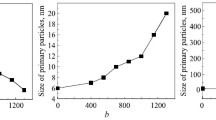Abstract
The methods of thermal analysis and X-ray diffraction are used to investigate polymorphic transformations taking place under heating and cooling in nonstabilized ultrafine ZrO2 powders (ZrO2 UFP) synthesized in a plasmochemical process. It is found out that ZrO2 UFP is characterized by an increased content (up to 55 mass%) of tetragonal-phase particles, which is associated with the size effect of its stabilization. Heating of UFP within T = (25–700) °C, which is followed by the release of H2O, CH2O, and CO2, does not result in a change in its structural-phase state, while annealing within the temperature interval T = (700–1,000) °C gives rise to an increased growth of the size of t-ZrO2 crystallites and results in an elevated tetragonality of the crystal lattice (c/a). A complete t-ZrO2 → m-ZrO2 transition occurs as a result of heating the powder up to T = 1,300 °C. The effect of the dimensional factor on temperature characteristics of polymorphic m ↔ t transitions and the value of their temperature hysteresis is established. It is shown that the powder particle size exerts the most pronounced influence on the temperature-dependent position of the point of martensitic transformation M s. As this influence is increased, M s is shifted toward the region of higher temperatures. This is followed by a decreased temperature hysteresis of the m ↔ t martensitic transformations.



Similar content being viewed by others
References
Dedov NV, Dorda FA, Korobtsev VP, Kutyavin EM, Soloviev AI. A plasmochemical process for manufacture of ultra- and finely dispersed metal oxide powders and their applications [in Russian]. Novye Promyshlennye Tekhnologii. 1994;1(221):38–42.
Patent RU 2076069, C01G25/02; 1997.
Larin VK, Kondakov VM, Malyi VA, Matykha VA, Dedov NV, Kutyavin EM, Stepanov IA, Ivanov YuF. A plasmochemical process for manufacture of ultrafine metal oxide powders and their promising applications. Izvestiya Vyschikh Uchebn Zaved Tsvetn Metal. 2003;5:59–64 (in Russian).
Ivanov YuF, Dedov NV. Diffraction analysis of nanometric zirconia powders. Fizika Khimiya Obrabotki Materialov. 1995;1:117–23 (in Russian).
Ivanov YuF, Tumanov YuN, Dedov NV, Khasanov OL. Structure and phase composition of nanostructured zirconia-base powder manufactured by plasmochemical synthesis. Fizika Khimiya Obrabotki Materialov. 2012;5:37–45 (in Russian).
Surzhikov AP, Frangulyan TS, Ghyngazov SA. A dilatometric study of the effect of pressing on the kinetics of compression of ultrafine zirconium dioxide powders under thermal annealing. Russ Phys J. 2012;55(4):345–52.
Surzhikov AP, Frangulyan TS, Ghyngazov SA. Thermoanalysis of phase transformation and linear shrinkage kinetics of ceramics made from ultrafine plasmochemical ZrO2 (Y)–Al2O3 powders. J Therm Anal Calorim. 2014;115(2):1439–45.
Chevalier J, Gremilland L, Vircar AV, Clarke DR. The tetragonal-monoclinic transformation in zirconia: lessons learned and future trend. J Am Ceram Soc. 2009;92(9):1901–20.
Subbarao E, Maiti HS, Srivastava KK. Martensitic transformation in zirconia. Phys Status Solidi A. 1974;21:9–40.
Bocanegra-Bernal MH, Diaz De La Torre S. Phase transformation in zirconium dioxide and related materials for high performance engineering ceramics. J Mater Sci. 2002;37:4947–71.
Garvie RC. Stabilization of tetragonal structure in zirconia microcrystals. J Phys Chem. 1978;82(2):218–24.
Garvie RC, Swain MV. Thermodynamics of the tetragonal to monoclinic phase transformation in constrained zirconia microcrystals. Part I: in the absence of an applied stress field. J Mater Sci. 1985;20(4):1193–200.
Kim DJ. Effect of Ta2O5, Nb2O5 and HfO2 alloying on the transformability of Y2O3-stabilized tetragonal ZrO2. J Am Ceram Soc. 1990;73(1):115–20.
Becher PF, Swain MV. Grain-size-dependent transformation behavior in polycrystalline tetragonal zirconia. J Am Ceram Soc. 1992;75(3):493–502.
Heuer AH, Lange FF, Swain MV, Evans AG. Transformation toughening: an overview. J Am Ceram Soc. 1986;69(3):1–4.
Moriya Y, Navrotsky A. High-temperature calorimetry of zirconia: heat capacity and thermodynamics of monoclinic-tetragonal phase transition. J Chem Thermodyn. 2006;38:211–23.
Lega D, Antonini A, Ciccioli A, Brutti S, Lenzuni P. Low scan DSC study of monoclinic-tetragonal transition in zirconia. Thermochim Acta. 2011;524:18–22.
Acknowledgements
This research is supported by The Ministry of Education and Science of the Russian Federation in part of the “Science” program.
Author information
Authors and Affiliations
Corresponding author
Rights and permissions
About this article
Cite this article
Surzhikov, A.P., Ghyngazov, S.A., Frangulyan, T.S. et al. Thermal transformations in ultrafine plasmochemical zirconium dioxide powders. J Therm Anal Calorim 119, 1603–1609 (2015). https://doi.org/10.1007/s10973-014-4318-x
Received:
Accepted:
Published:
Issue Date:
DOI: https://doi.org/10.1007/s10973-014-4318-x




